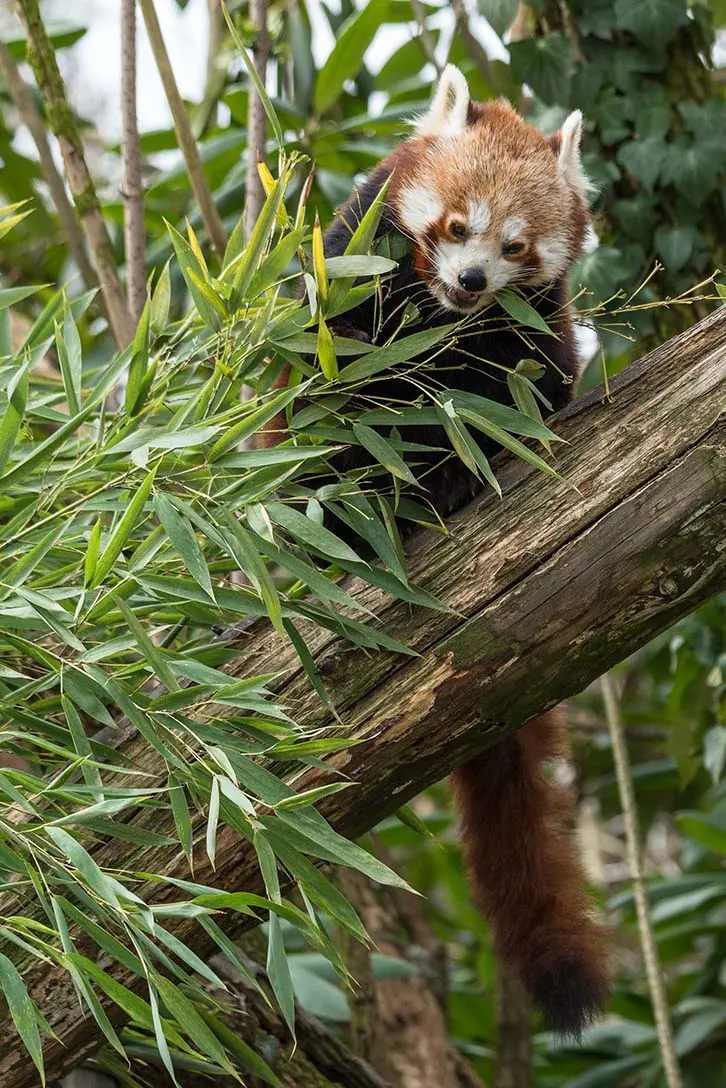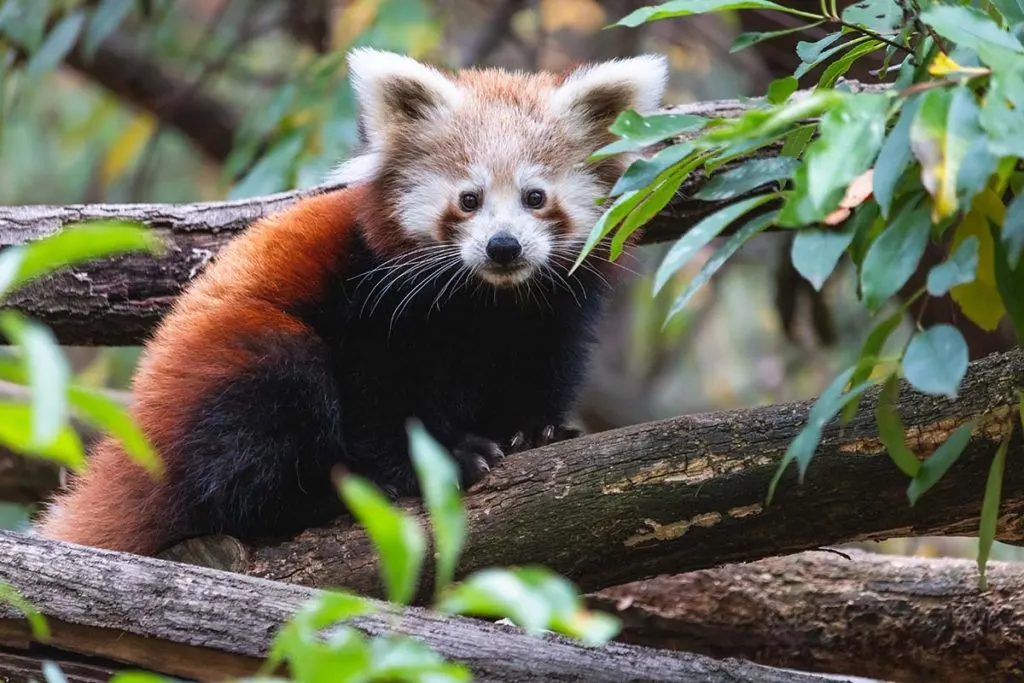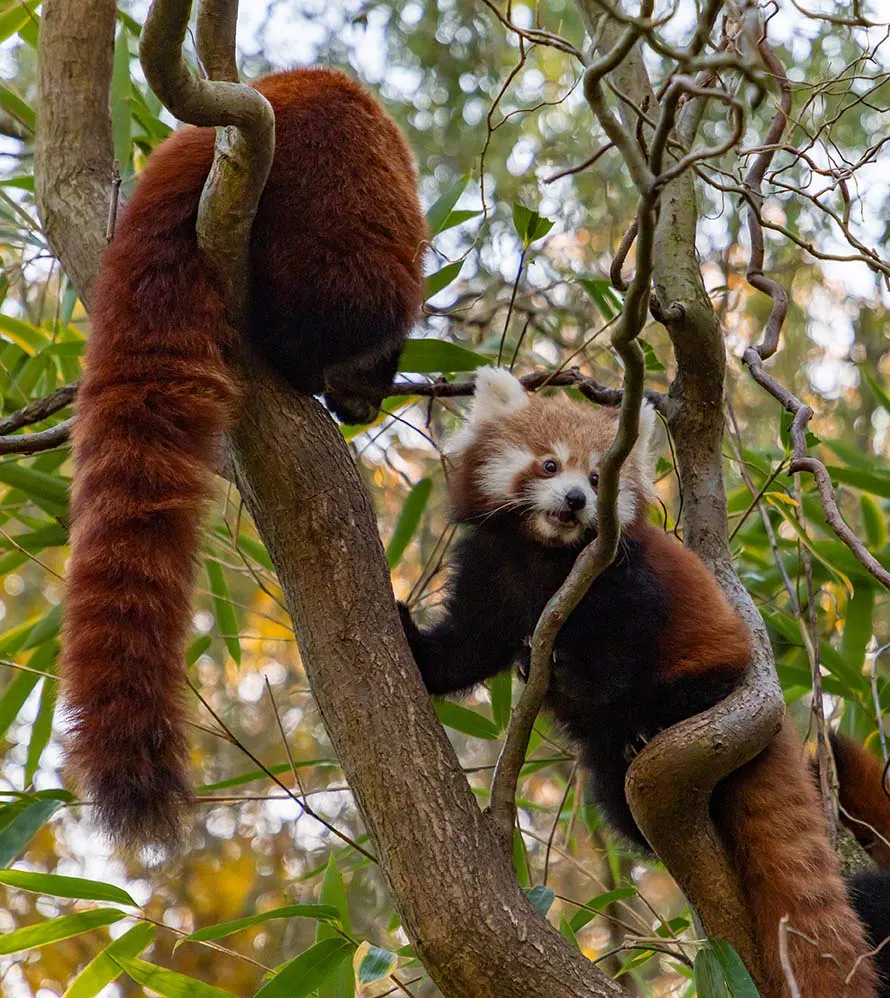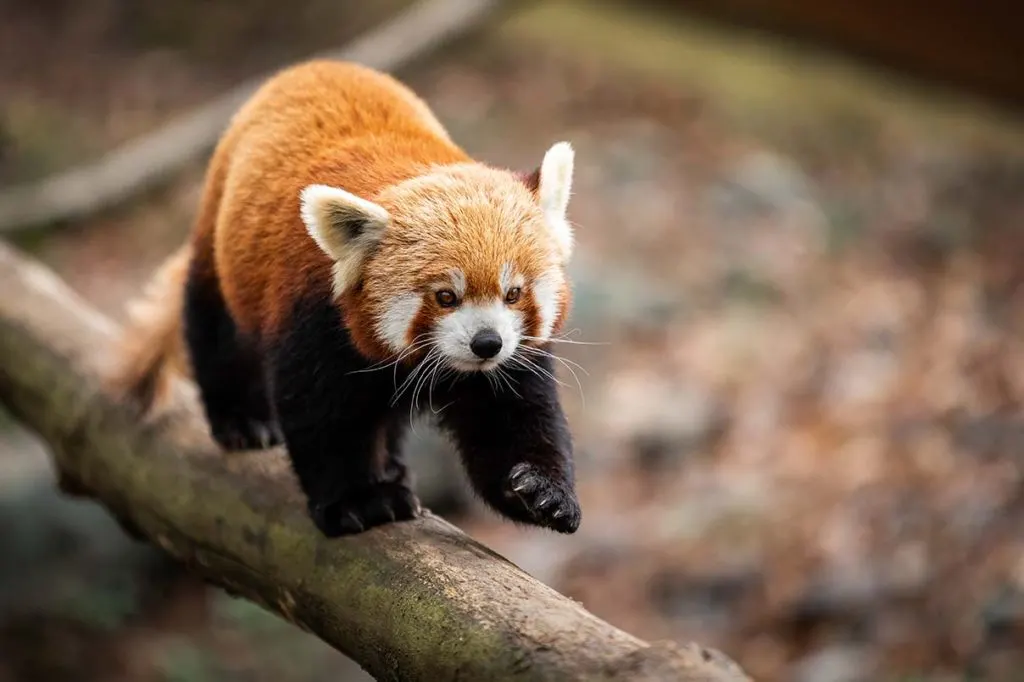Did you know that red pandas are the original pandas? Find out this and more fun red panda facts for kids in this post.

The shy red panda lives in the Eastern Himalayas and South-western China. The red panda is recognizable by its red coloring, long bushy tail and racoon like features.
Red pandas are also known as “firefox”, “lesser panda” and “red-cat-bear.” Red pandas are the original panda. They were named 50 years before the giant panda was named.
Physical Description
Red pandas are roughly the size of a large domestic cat. They are usually between 20 to 26 inches long with a tail around 12 to 20 inches. They weigh 12 to 20 pounds. They have distinctive coats that are reddish brown above and black underneath with white markings on the face.
Habitat
Red pandas live in the Himalayas of Nepal, India, Bhutan, Myanmar and southern China. They spend 90% of their time in the trees of the temperate broadleaved forest with bamboo in the undergrowth at an altitude of 7,800 to almost 13,000 feet.

Habits
Red pandas are crepuscular which means they are most active in the early morning and late afternoon. They are arboreal, spending most of the day resting in trees. Red pandas are solitary but come together during their mating season.
Spending time in trees is how these animals avoid predators. They only go to ground to use the bathroom. They climb down head first by rotating their ankle 180 degrees. This gives their curved claws a better angle to hang from the bark.
Facts about the Diet of Red Pandas
The red panda diet is 90% bamboo. They select the leaf tips and shoots of the bamboo plant. They prefer short and robust bamboo shoots over tall ones. They eat about 20,000 bamboo leaves every day. The remaining 10% of their diet is primarily comprised of berries, insects, eggs, mushrooms, flowers, birds, and maple and mulberry leaves.

Offspring
The mating season for red pandas is from mid-January to early March. They usually mate with more than one partner. Red panda females have low birth rates in the wild and on average only deliver two cubs per year.
Red panda gestation is usually between 112 to 158 days. A few days before giving birth, a pregnant red panda will build a nest for her baby in a tree stump or hollow tree. The nests are made of grass, leaves, moss, and tree branches.

Red pandas give birth between mid-June to late July and will have between 1 to 4 cubs, but 2 is the usual. Cubs are born covered in thick gray fur, and their eyes and ears are closed. They weigh between 3.8 and 4.2 ounces (110-130g). Cubs stay in the nest for the first 3 months of their lives. They will stay with their mother until the next mating season.
Red pandas can start reproducing at the age of 18 months, but they are not fully mature until around 2 to 3 years.
Classification/Taxonomy
Kingdom: Animalia
Phylum: Chordata
Class: Mammalia
Order: Carnivora
Family: Ailuridae
Genus: Ailurus
There are 2 species of red panda:
Species: Ailurus fulgens — Himalayan red panda
Species: Ailurus styani — Chinese red panda
History
The ancestors of modern bears split into 2 lineages between 30 to 50 million years ago. The fossil record shows the ancient relatives of the red panda lived in North America between 4.5 to 12 million years ago. The two species of red pandas split about 250,000 years ago.

Predators
Red panda predators include snow leopards and martens, a weasel-like carnivore. Birds of prey are predators of red panda cubs. Humans are a threat to the red panda and their habitat.
Their unique coats help camouflage them from their predators, as they blend in great with the red moss, white lichen, and yellow-orange-red foliage of their forest habitat.
Lifespan
The wild red panda’s lifespan is 8 to 10 years on average. In captivity, they can survive up to 15 years. There is even record of a red panda living to 23 years.

25 Unusual Facts about Red Pandas
- Red pandas have a false thumb (an extended wrist bone that developed over time to help with tree climbing and bamboo eating.
- The web browser Firefox is named for the red panda.
- Habitat loss and hunting has led to red pandas becoming endangered.
- Red pandas wrap their tails around themselves to keep warm in their chilly habitat.
- Red pandas can run up to 40 kmph.
- Red pandas have 38 teeth.
- Master Shifu from the movie Kung Fu Panda is a Red Panda.
- Red pandas love the winter and playing in the snow. They can tolerate cold temperatures up to -30°C.
- The red ‘tear tracks’ from the red panda’s eyes help them keep the bright sunlight out of their eyes by reflecting the sun, providing them with better vision on a sunny day.
- Red pandas are very quiet. However, they can squeal, chirp, and huff-quack.
- Male red pandas are known to be territorial and will mark their territory using a strong odor from the scent gland. Similar to the skunk, they also use their scent to repel predators.
- Red pandas clean themselves with their paws like house cats.
- Red pandas are good swimmers.
- They love sunbathing on a very cold day.
- There are fewer than 10,000 in the wild. It’s estimated that there’s been a 40% decrease in numbers over the last 50 years.
- Even though their diet is 90% bamboo, their digestive system is not very good at processing the cellulose components of the plant cell.
- Newborns hardly have any fur on the bottoms of their feet. The fur grows as they get older.
- The earliest reference to the red panda is from a 13th century Chou Dynasty scroll.
- Red panda fur is considered good luck by some tribal people. Red panda fur hats are worn in many regions, especially by bridegrooms.
- When traveling on business, spotting a red panda is considered to be a good omen.
- In Central Bhutan, red pandas are thought to be the reincarnation of Buddhist monks.
- Red pandas are considered vegetarian carnivores. They are classified as carnivores because they're descended from the same ancestors as other carnivores, but they rarely eat anything other than bamboo.
- Red pandas in captivity are very clever at escaping their enclosures. So much so that the Association of Zoos and Aquariums even warn in their official care manual, “Beware: red pandas are escape artists”.
- While they do not hibernate, red pandas can become dormant in very cold temperatures. Their metabolic rate lowers and only increases every few hours to wake them up to look for food.
- In 2010, International Red Panda Day began. It is celebrated on the third Saturday of September to raise support and awareness for red panda conservation.
Check out these other cool mammals!
